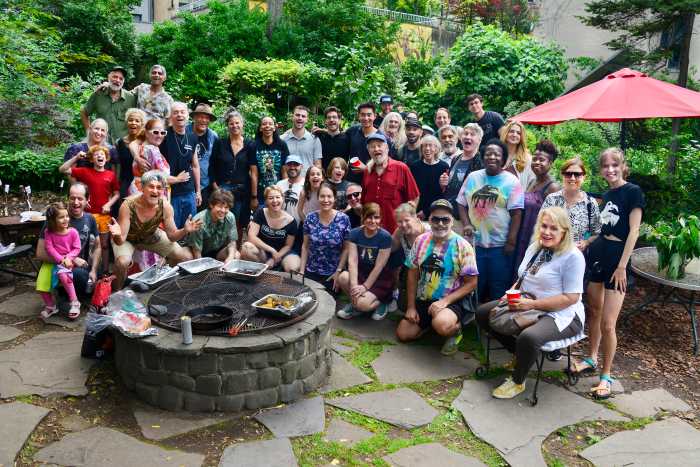By Albert Amateau
Village neighbors, postal union representatives and elected officials rallied in front of the West Village post office last week to protest the U.S. Postal Service’s plan to close the station in October.
The full-service post office at 527 Hudson St. is one of five stations in Manhattan, including the Pitt St. post office next to the Seward Park Co-op on the Lower East Side, and 14 total in all five boroughs proposed for closing because of decreased mail volume and a corresponding decline in revenue for U.S.P.S.
It is the second time in two years that the West Village station has been threatened. In 2007 the full-service post office was scheduled for conversion to an automated center that would not be able to issue postal money orders. After protests led by elected officials, full service remained with automatic machines added. About a year ago, the station was closed for several months for a $250,000 renovation.
Congressmember Jerrold Nadler and Clarence Wall, executive vice president of the postal workers union in the New York metro area, told the Aug. 20 rally at the Hudson St. post office that the union believes there is no economic justification for closing the station.
“I’m not convinced that these closures would create real relief from the Postal Service’s budget crisis,” said Nadler, adding, “As far as I can see, the cuts are akin to moving furniture around on the Titanic.”
Nadler announced that he was sponsoring two bills in Congress. The intention of one bill would be to save U.S.P.S. $3.5 billion per year in operating expenses. The other bill would require U.S.P.S. to fully justify station closings and service consolidations, and would require hearings and a public assessment of the need for a station closure or consolidation.
Wall said that if it were not for $2 billion that Congress last year forced U.S.P.S. to prepay into its employee health insurance, the Postal Service would have shown a surplus this year.
City Council Speaker Christine Quinn, whose district includes the West Village, told the rally that revenues alone couldn’t measure the importance of local post offices.
“Local post offices keep us in touch with our friends and families,” she said. “Can you imagine what Christmas would be like without a post office near where people live? They are a necessity. A post office is like a community center where people meet their neighbors. Closing post offices needs to be done with a scalpel, not a machete,” Quinn said.
State Senator Tom Duane, whose district includes the West Village, Assemblymember Linda Rosenthal, representing Clinton and the Upper West Side, and State Senator Daniel Squadron, whose district includes the Lower East Side and most of the East Village, also spoke at the rally. Staff members for Assemblymembers Deborah Glick and Richard Gottfried were also at the rally.
Nadler said the privatization of the U.S. Postal Service a decade ago into a private public-benefit organization that receives no subsidy from federal tax funds was a big mistake.
“Mail service is a public good. It’s as old as the United States — started by Benjamin Franklin,” he said, adding, “It was an illusion to believe that the Postal Service could sustain itself.” He acknowledged, however, that there does not appear to be support in Congress to reverse the privatization. “That may change if there are many more station closings,” he said.
At the end of last month, representatives from Assembly Speaker Sheldon Silver’s Office led a rally in front of the Pitt St. post office protesting the station’s planned closing. The Pitt St. station, at 185 Clinton St., leases it premises from the Seward Park Co-op.
The West Village station in July began distributing questionnaires to its patrons as part of the review of the potential closing. But many Villagers felt the questions were rigged to show that the nearby post office at 201 Varick St. could serve West Village residents.
Steve Gould, a staff member of Visiting Neighbors, which serves elderly Village residents, said the organization has many clients in the West Village who are older than 80.
“They can’t be asked to walk to Varick St., more than seven blocks further away,” he said at the Aug. 20 rally.
Harry Malakoff, a real estate broker and W. 12th St. resident, recalled that when he was a college student 40 years ago, his political-science professor told the class that one of the duties of a congressmember was to make sure the district had a post office.
Albert Bennett, a Morton St. resident and member of his block association, said the West Village station is necessary for the association to send its monthly newsletter to residents.
“Closing the station would be the death of the Morton St. Block Association,” he said.
Jo Hamilton, chairperson of Community Board 2, said, “We fought the battle two years ago to save the West Village post office. Community Board 2 is very, very strongly behind our congressman’s calls to save that post office. Whenever I go there, it’s always crowded, which shows how heavily it’s used.”
A U.S.P.S. spokesperson said none of the city’s 14 threatened stations would be closed until after a review of the situation is completed Sept. 30 and hearings are held for each closing.





































